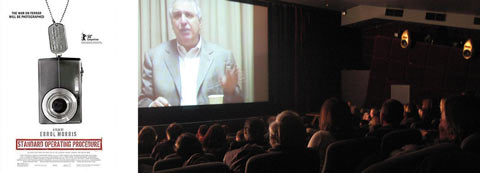Deconstructing the photographs of Abu Ghraib with Errol Morris.
Melbourne’s Cinema Nova recently screened the latest Errol Morris documentary, and a few minutes after it finished, cut to the director on the screen, who chatted and answered audience questions enthusiastically for some 45 minutes via satellite ( or skype / ichat ). Felt quite the privilege to have such direct access to Errol, straight after his compelling and confronting exploration of events at Abu Ghraib, hearing his clarifications and reasonings behind his film making decisions. And felt surprisingly natural to have the director on screen at the audience’s disposal, a pretty effective way of distinguishing a cinema house from a home theatre, likely something we’re going to see more.
“Cinematic interventions? Oh, that makes me sound like some kind of psychiatric social worker.. ( much audience laughter ), ” was his response to an early question about his use of heavily stylised renactments within the film.
“I liked to think of them as ‘visual moments’ .. and the most important is that the filmmaker seeks truth, then the techniques available can be used in service of this.”
The truth Errol seeks in Standard Operating Procedure is the wider context and realities surrounding the events in the Abu Ghraib prison in Iraq. The prison received global attention in 2004 when photographs were released detailing many instances of humiliating and degrading behaviours and events seemingly being orchestrated by U.S. prison guards. Central to Errol’s film is examining these photographs with a range of interviewees ( including several of the guards ) and forensic experts and trying to piece together what actually happened, and to what extent the individuals charged and imprisoned were acting according to their own impulses or to instructions from above as part of a larger system.
A few key points jumped out from the screening :
– although a military prison, the majority of those imprisoned were local males of ‘fighting age’ who had been gathered from the streets for various minor or alleged offences.
– The photographs shown were from the ‘softening process’, something that was used before the prisoners were sent to be tortured. This was a preparation phase, and the public hasn’t seen photos from the ‘torture phase’.
– the guards repeatedly described how they had arrived into and were consistently given instructions from above.
– No-one higher in rank than the low ranking officers witnessed in the photographs has been charged or imprisoned, despite one of the photographs containing the dead body of a man who had died during torture, effectively having been murdered in prison.
The film is disturbing on many levels, and achieves it’s power in part from the way Morris interviews his subjects – he uses what he calls the interrotron ( see diagram : http://tiny.cc/iSgsv ), a camera technique he invented using a teleprompter to show the interviewers face in front of the camera lens, which allows the interviewee to make eye contact with the audience. And so much of the film involves U.S. military prison guards detailing explicit and depraved scenarios but while seeming to stare across with coffee table intimacy. In the Q+A afterwards, Morris was asked about this and pointed out that the person asking that very question had to choose between looking into a camera and looking at Errol on the screen, but couldn’t do both, hence Errol was seeing video of someone who was looking off to one side
Errol’s Got A Pedigree
The Fog of War – about the life and times of former United States Secretary of Defense Robert S. McNamara, won best documentary academy award in 2004, but several of his earlier documentaries weren’t nominated as his various experimental techniques ( in the service of telling the story ) caused concern with the oscar givers.
The Thin Blue Line – investigated the murder of a police officer and famously helped someone facing the death penalty in texas get released, and introduced stylised renactments as a controversial technique for documentary making back in 1988.
A Brief History of Time – documented the life of physicist Stephen Hawking.
Fast, Cheap and Out of Control – a lion trainer, a topiary sculptor, a mole rat specialist, and a robot scientist, got the specialised Morris doco-treatment.
Mr. Death: The Rise and Fall of Fred A. Leuchter, Jr – interviews with an execution technician (!) who is also a holocaust denier because he cannot conceive that the Auschwitz gas chambers were technically possible ( not that Fred has researched this much at all ).
Gates of Heaven – Errol’s first documentary about a pet cemetery business – and which spawned a short film in response : “Werner Herzog Eats His Shoe” in which the German director held up his part of a bet and cooked his shoe on stage with herbs and garlic then ate it upon Errol’s finishing the film.

